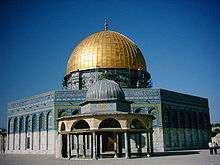Dome of the Chain
-Jerusalem-Temple_Mount-Dome_of_the_Chain_(south_exposure).jpg)
Dome of the Chain (Arabic: قبة السلسلة, Qubbat al-Silsilah) is a free-standing dome located adjacently east of the Dome of the Rock in the Old City of Jerusalem. One of the oldest structures on the Haram ash-Sharif (Temple Mount), it is not a mosque or shrine, but is used as a prayer house.[1] It was built by the Umayyads, became a Christian chapel under the Crusaders, restored as an Islamic prayer house by the Ayyubids and has been renovated by the Mamluks, Ottomans and the Palestinian-based waqf.
History
Some architectural elements used as part of the structure date to pre-Islamic times,[2] but it is widely accepted by both Arab and Western scholars that the Dome of the Chain was originally built in 691 by the Umayyad caliph Abd al-Malik.[1][3] The Umayyad design of the building has largely remained unaltered by later restorations.[2] In addition to being a prayer house, the dome was used as a treasury for the local Muslim community.[4]
When the Crusaders invaded the Levant in 1099, they identified the dome as the spot where Saint James was martyred, and transformed the building into a chapel dedicated to him within the Templum Domini. In 1187, the building was returned to Muslim use after Saladin captured Jerusalem from the Crusaders. In 1199–1200, the ceiling and pavings were renewed by the ruling Ayyubids.[2] The Christians re-used the place in 1240–1244, before it reverted to Muslim use. The structure was renovated by the Mamluk sultan Baybars (r. 1260–1277). The latter's renovations likely involved the refacing of the mihrab with marble. In 1561, under the Ottoman sultan Suleiman the Magnificent, the tiles of the mihrab were glazed and later in 1760, more tile work was done.[2]
The last major restoration undertaken at the Dome of the Chain was commissioned by the Islamic waqf of Jerusalem in 1975-76.[2]
Religious significance
The Dome of the Chain owes its name to an ancient legend during King Solomon's rule. According to Mujir ad-Din,
Among the wonders of the Holy House is the chain, which Solomon, son of David, suspended between Heaven and Earth, to the east of the Rock, where the Dome of the Chain now stands. The chain had one characteristic. If two men approached it to solve a point of litigation, only the honest and upright man could take hold of it; the unjust man saw it move out of his reach.[4]
The building in Islamic tradition is the spot where Judgment Day will occur in the "end of days" and where a chain will stop the sinful and let the just pass through. Notably, the mihrab in the al-Aqsa Mosque is located exactly in the middle of the qibla wall of the Temple Mount on north-south axis with the Dome of the Chain.[3]
Architecture
-Jerusalem-Temple_Mount-Dome_of_the_Chain-Mihrab.jpg)
The building consists of a domed structure with two concentric open arcades, that is: with no lateral walls closing it in. The dome, resting on a hexagonal drum, is made of timber and is supported by six columns which together create the inner arcade. The second, outer row of eleven columns creates an eleven-sided outer arcade. The qibla wall contains the mihrab or prayer niche and is flanked by two smaller columns.[2] There are a total of seventeen columns in the structure, excluding the mihrab. It is known from historical sources that initially there used to be twenty columns, indicating a radical rebuilding phase, probably in the 13th century.[4] The Dome of the Chain has a diameter of 14 meters (46 ft), making it the third largest building on the Haram after the al-Aqsa Mosque and the Dome of the Rock.[3]
Dome of the Rock model theory
According to a number of early Arab historians, the Dome of the Chain was used as a model for the Dome of the Rock. Like the latter, the Dome of the Chain consists of two concentric polygons, with columns bound together by arcades and wooden beams. The Dome of the Rock is three times the size of the Dome of the Chain and the ground plan and height are relatively proportional.[5] What does not seem to support this theory is the contrast between the perfect octagonal symmetry of both archways of the Dome of the Rock, and the mix of a hexagonal inner arcade and an (initially) fourteen-sided outer one for the Dome of the Chain. The lack of an outer wall is an additional issue. The original purpose of the Dome of the Chain is so far unknown.[4]
See also
Gallery
- Dome of the Chain, interior detail
- Dome of the Chain with Dome of the Rock detail behind
References
- 1 2 Al-Aqsa Guide: 31. Dome of the Chain (Silsilah) Al Aqsa Friends 2007. Archived October 6, 2008, at the Wayback Machine.
- 1 2 3 4 5 6 Pringle, Denys. (1993). The Churches of the Crusader Kingdom of Jerusalem: A Corpus, Vol. III Cambridge University Press, pp.182-184.
- 1 2 3 Dome of the Chain Archnet Digital Library.
- 1 2 3 4 Murphy-O'Connor, Jerome. (2008). The Holy Land: An Oxford Archaeological Guide from Earliest Times to 1700 Oxford University Press, p.97. ISBN 0-19-923666-6.
- ↑ Conder, Claude Reignier and Palestine Exploration Fund. (1887). Tent Work in Palestine: A Record of Discovery and Adventure R. Bentley & Son, 165.
Coordinates: 31°46′41.00″N 35°14′08.94″E / 31.7780556°N 35.2358167°E
